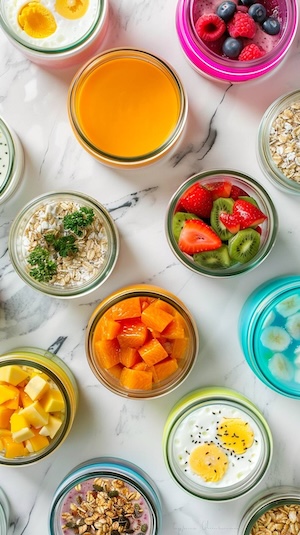Best Cereal for PCOS: Brands Ranked & Reviewed
Discover the best cereal for PCOS with our expert rankings. Compare brands, check ingredients, and find PCOS friendly cereal that supports hormonal balance.
This recipe includes superfoods such as:
Transform your health with tailored 7-day meal plans designed specifically for PCOS management. Just $7/month or $59/year.
Get it now →8 to 12 ounces butternut squash, cut into 1/2-inch cubes
2 teaspoons olive oil
1 cup heavy cream
1 cup whole milk
1 teaspoon honey
1/2 cup light brown sugar
8 large egg yolks
1/2 teaspoon curry powder
1/2 teaspoon kosher salt
1/4 teaspoon ground cumin
1/8 teaspoon ground cloves
1/8 teaspoon ground black pepper
Preheat the oven to 400 degrees F. Toss the squash cubes in the olive oil and spread them out on a baking sheet. Roast until the squash is tender and starting to caramelize, 45 to 50 minutes. Set aside to cool. Once the squash has cooled slightly, transfer it to a food processor and puree until smooth. In a large saucepan, combine the cream, milk, honey and 2 tablespoons of the brown sugar, and bring to a mild simmer over medium heat. In a bowl, whisk the egg yolks vigorously until they turn pale yellow. Add the remaining 6 tablespoons brown sugar and stir to fully incorporate. Temper the eggs by slowly adding one third of the heated cream while whisking continuously. Pour the tempered egg mixture back into the saucepan with the rest of the cream and cook over low heat (do not boil!), stirring constantly with a wooden spoon, using figure-eight motions. Cook until the custard begins to thicken and coat the back of the spoon, anywhere from 15 seconds to 1 minute. Pour the custard through a fine mesh sieve into a clean bowl set over an ice bath. Stir until the custard is completely cooled. Combine a third of the cooled custard with 1/2 cup of the squash puree (doing this in a small batch will ensure a smoother texture), and use an immersion blender to blend until smooth. Add the custard-squash mixture back into the remaining custard. Stir in the curry powder, salt, cumin, cloves and black pepper. Blend and emulsify with the immersion blender until smooth. Strain, then cover and refrigerate for 4 hours to overnight. Pour the custard into the bowl of an ice cream maker and churn according to the manufacturer's directions. Transfer to a container suitable for the freezer and freeze for at least 2 hours before serving.

You know the drill: Alarm goes off. You hit snooze. Rush around frantically. Skip breakfast AGAIN because there's no time. By 10am, you're hangry, your blood sugar is all over the place, and your PCOS symptoms are already acting up.
Sound familiar?
Finally – a meal prep system designed specifically for women with PCOS who refuse to let chaotic mornings derail their health goals.
In just ONE hour on Sunday, you can transform your entire week:
"I went from skipping breakfast 4 days a week to having delicious, hormone-supporting meals ready every morning. My energy is more stable and my cravings have disappeared!"
– Sarah M.
Stop letting chaotic mornings control your health.
Get your hormone-happy mornings starting this Sunday.
→ Get Your 60-Minute Solution Now
Transform your health with tailored 7-day meal plans designed specifically for PCOS management. Just $7/month or $59/year.
Get it now →Serving Size: 1
| Amount Per ONE Serving | ||
|---|---|---|
| Calories 0 kcal | ||
| Fat 0 g | ||
| Carbohydrate 0 g | ||
| Protein 0 g | ||
💡 Introducing the 10/10 PCOS Solution:
Ten Delicious Crockpot Recipes that take just 10 minutes to prep!
Say goodbye to hours in the kitchen and hello to clean, PCOS-friendly meals made effortlessly.
👉 Click here to grab your 10/10 PCOS Solution today! Try The 10/10 PCOS Solution: Ten Crockpot Recipes That Take Just Ten Minutes to Prep
Managing PCOS can be challenging, but you don't have to do it alone. Join our supportive community to connect with others who understand what you're going through, share tips, and get encouragement. Here's how you can get involved:
Subscribe to our Newsletter: Receive PCOS-friendly recipes, tips, research updates, and more delivered straight to your inbox. Stay informed and empowered with the latest information and support.
Join our Telegram Channel: Stay updated with the latest tips and advice on managing PCOS.
Follow PCOS Meal Planner on Facebook: Engage with our community, participate in discussions, and get support from others.
Break the cycle with the PCOS Meal Planner - your personalized guide to eating better, feeling better, and managing PCOS symptoms. Take control today!

Forget the frustrating cycle of weight loss attempts, endless medications, and living in discomfort. Introducing the PCOS Meal Planner. A meal planning guide that goes beyond temporary fixes to offer a comprehensive strategy, empowering you to ignite a transformation towards lasting health and happiness. Step into a world where you control your PCOS, not the other way around.
Unlock Your PCOS Freedom Now.
Discover the best cereal for PCOS with our expert rankings. Compare brands, check ingredients, and find PCOS friendly cereal that supports hormonal balance.
Learn how to transition away from fruit when starting a ketogenic diet for PCOS. Discover gradual strategies, fruit alternatives, and practical tips for success.
Discover 5 delicious PCOS banana bread recipes with low-glycemic ingredients. Learn how to make hormone-friendly banana bread that supports blood sugar balance.
Creatine for women with PCOS explained simply. Learn safety, benefits, hormone effects, tips, and how creatine may support PCOS symptoms naturally.
Complete PCOS diet plan with foods to eat, foods to avoid, meal timing, and real results. Learn the science-backed approach to managing PCOS through diet, with 7-day meal plan, grocery list, and step-by-step implementation guide. Based on clinical research and real patient outcomes.
Complete guide to ordering at Wendy's with PCOS. Discover the best protein-focused meals, what to skip, and how to customize orders to keep blood sugar stable. Learn which burgers, salads, and sides work for PCOS, plus complete macros for every menu item and smart swaps to avoid insulin spikes.
Complete guide to ordering at Burger King with PCOS. Discover the best protein-focused meals, what to skip, and how to customize orders to keep blood sugar stable. Learn which burgers, salads, and sides work for PCOS, plus complete macros for every menu item and smart swaps to avoid insulin spikes.
Discover 30+ delicious PCOS-friendly smoothie recipes that stabilize blood sugar and support hormones. Each recipe includes protein macros, glycemic load, and hormone-balancing ingredients. Find breakfast smoothies, post-workout options, green smoothies, and dessert alternatives - all designed to prevent insulin spikes while satisfying cravings.
Discover the best supplements for PCOS backed by clinical research. Learn which supplements improve insulin resistance, reduce androgens, support ovulation, and balance hormones. Complete guide with dosages, timing, brands, and what to avoid. Evidence-based recommendations for inositol, vitamin D, omega-3, berberine, and more.